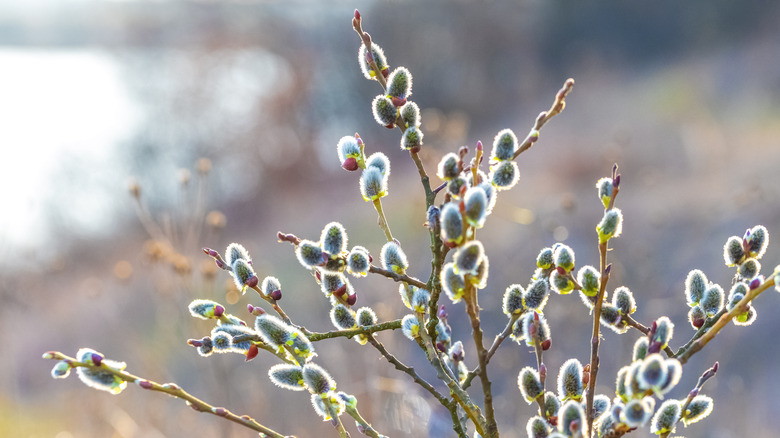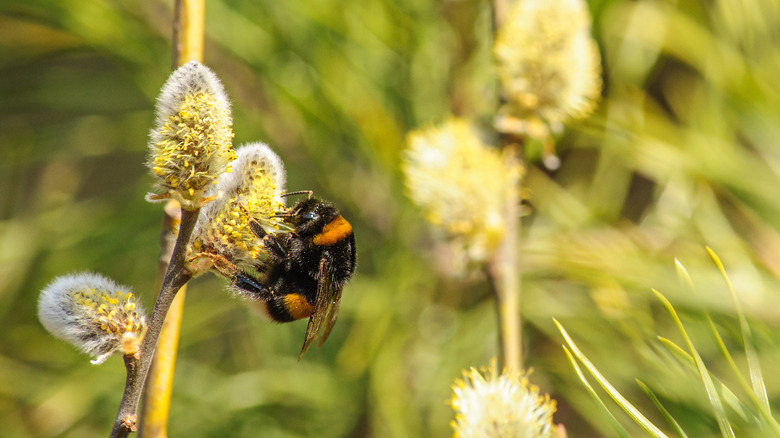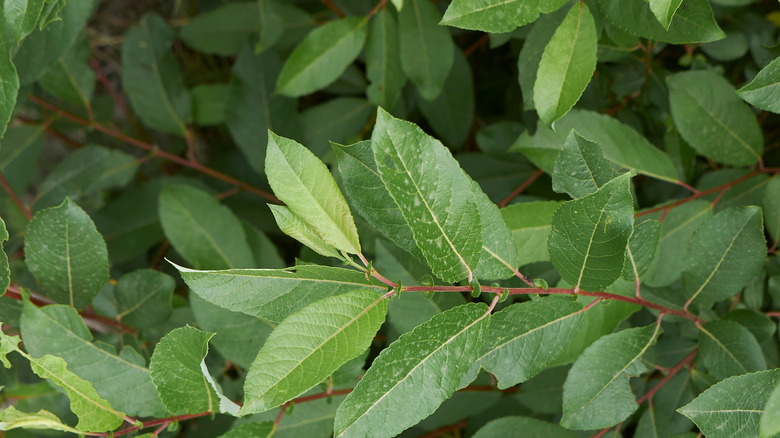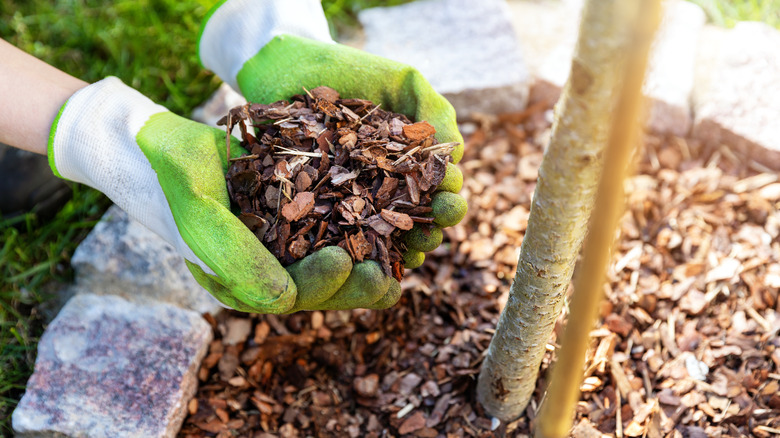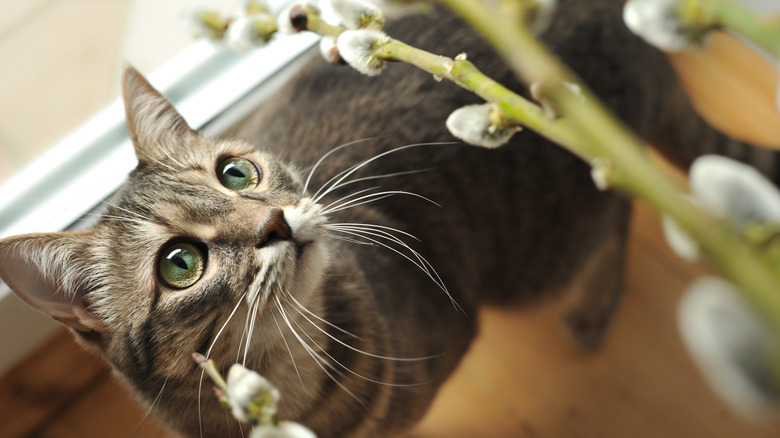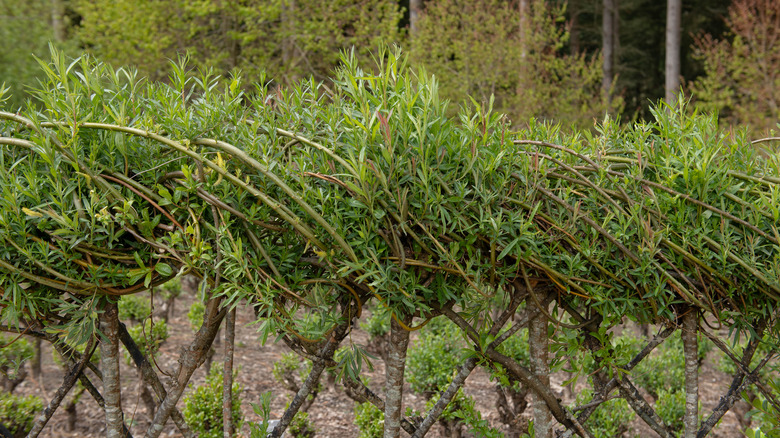How To Properly Care For Your Pussy Willows
There is something magical about the pussy willow. Who has seen a branch and not imagined tiny silver kittens, curled at each bud? To touch them is sensory bliss. To find them in the landscape among spare stalks and the craggy bark of overwintered trees is a message of hope — for spring and warmer days. Just what are these seeming anomalies of nature, and how do they grow?
Pussy willows are actually willow trees with apetalous flowers. There are a few varieties; the Salix discolor is most widely recognized, with delicate, pearl grey buds. According to the Brooklyn Botanical Garden, the velvety fur is a layer of hairs meant to protect the buds from cold while the flower fully develops. They are easy to grow and care for; consistently damp soil and partial to full sun are prime conditions. Per The Spruce, a cutting impaled into dirt in the right location demands virtually nothing from the gardener but to watch it grow.
Pussy willows are springtime bloomers with buds that erupt into fuzzy catkins (katteken -- kitten, from the Middle Dutch language) as the flowers arc toward maturity and before leaves resprout. This is when the blooms are their softest because the pollen filled stamens have not yet emerged from their insulating cover. As male flowers develop, they'll become yellow with pollen; at this stage, Vermont Land Trust explains, wind, visiting pollinators, and other unwitting wildlife will fertilize the female flowers.
How to use pussy willows in garden
Pussy willows provide habitat for various moths and butterflies while in their larval phase, and nesting materials and locations for numerous birds. Consider placing some pussy willows near your garden to attract them; according to Morning Chores, many varieties that shelter in shrubs and thickets also prey upon stubborn garden pests like aphids, grasshoppers, and grubs. However, SFGate recommends protecting newly seeded gardens and tender sprouts temporarily with row covers or stakes. The Spruce cautions that the roots can be invasive and grow quite deep, so avoid planting pussy willows near septic tank fields, water lines, hardscaping, and foundations. This trait conversely makes them a viable option for flood management along streams and shorelines, and is used to advantage as erosion control on hills.
Pussy willow thickets make wonderful privacy hedges, attracting pollinators, and other wildlife. (The Xerces Society asserts that pussy willows are an important source of nectar since their blooming fills a void for early season pollinators.) Rods can be patterned into beautiful living fences (or fedges), arches, and obelisks. Prevalent in historic and English garden design, they're environmentally friendly and blend organically into the landscape. And they might even help your garden grow.
How to grow pussy willows
A male pussy willow tree must be grown for those recognizable fuzzy caps — willows are dioecious, per the Brooklyn Botanical Garden, which means there are male and female plants — while the female has a flower resembling a giant spiked bug. At the nursery, avoid plants that appear stressed; The Spruce describes some tell-tale indicators: wilting, dull, or yellowing foliage, legginess, insect activity, and cracked stems. Look for firm buds and a root ball that is solid and not overly light for its size, a sign of dehydration.
According to SFGate, the optimal time of year for planting pussy willows is in fall; roots grow more successfully in cooler temperatures when energy is invested toward root growth rather than leaf production. Choose a site located in partial to full sun with soil that is generally moist. HGTV recommends loosening compacted and clay soils with peat moss, and enriching with compost. Elemental sulphur can be added if necessary, as pussy willows prefer a slightly acidic environment. Dig out twice the width and a little deeper than the nursery container, prepping the hole at least a day in advance of planting so soil can settle. Massage the roots and lower the tree into the ground, adding back the amended dirt until the hole is filled. Tamp the soil down and water well. Finally, insulate with a layer of gardening mulch, leaving a buffer at the base of the trunk to ensure air flow and discourage rot.
How to care for pussy willows
While relatively care-free to grow, some maintenance ensures flourishing pussy willows. HGTV recommends late winter annual pruning to encourage uniform structure and straight stems, while keeping branches from growing too long, and consequently less strong. Proper pruning also inhibits fungus and disease; waiting until after new shoots have formed decreases the plentitude of those fuzzy buds the following year, so it's best to do it immediately after flowering. Use pruning shears to cut off the ends of the stems containing the catkins, then prune them again to match the height of new growth. Trim a third of the length from oldest branches, and remove any dead or damaged wood. More aggressive renewal pruning can be undertaken every few years by cutting the entire plant back severely, almost to ground level.
Pussy willow trees are moderately susceptible to pests and disease. Sanitizing pruners in rubbing alcohol prevents the spread of pathogens from one plant to another, and within the same plant. Epic Gardening explains that neem oil or insecticidal sprays can be employed to support plants that are host to aphids and scale insects. The Spruce suggests chicken wire or plastic fencing as protection against feeding wildlife; deer, squirrels, rabbits, and small rodents consume the bark and leaves, potentially causing damage.
No bowls of milk are necessary, but pussy willows love their water, so keep them hydrated! An application of mulch at the base of the tree or thickets will help to retain moisture.
Varieties of pussy willow
Pussy willows thrive in the northern United States and parts of Canada — USDA plant hardiness zones 4 and 5. Endemic in wetlands, they grow along streams and in boggy areas, but are resilient plants, useful to the gardener in drier soils as well.
Salix discolor (American Pussy Willow), Salix caprea (Goat Willow), and Salix cinera (Gray Willow) are small deciduous trees or shrubs, commonly referred to as pussy willow. Salix discolor is the "official" pussy willow, native to North America; according to Epic Gardening, it generally grows in the range of 6 to 8 feet, and to a maximum of 20 feet. The Goat Willow is a Eurasian variety, per Trees for Life, that sometimes reaches 40 feet, and has been known to survive for 300 years! The Gray Willow is a multiple stemmed shrub that should be avoided by the gardener. This non-native species was introduced for riverbank erosion control, but the Lower Hudson Partnership for Regional Invasive Species Management (LH Prism) explains that it is now considered invasive, hybridizing with and displacing indigenous plants. Of these three varieties, the Salix discolor is the easiest to propagate.
Are pussy willows toxic?
Somewhat ironically, pussy willows contain compounds called salicylates that can be toxic to cats; beneficial to the plant, the compounds have antiseptic and anti-microbial properties which support a healthier environment for propagation. Hepper specifies there is cause for concern only when ingested in large amounts. If planted in your yard or nearby, don't allow your cat outside unattended, or bring cuttings into the house.
The Cincinnati Children's Drug and Poison Information Center classifies pussy willows as non-toxic to humans. Little ones may be tempted by an indoor bouquet, breaking off fragile catkins or putting them in their mouths. There's not much reason for worry other than for the longevity of the branches. In addition, those soft and furry buds can be a haven for dust mites so you may want to keep them out of reach. And, as eHow suggests, occasionally give them a gentle cleaning with the blow-drier.
How to grow pussy willows from cuttings
HGTV claims it's so easy to do, that most gardeners choose to grow their own pussy willows from cuttings. Prune 1/4-inch thick, foot long sections of new growth at an angle, and root them in water or soil. Once rooted, the cuttings can be placed in the desired locations; prepare the area first with pre-made holes and dirt fortified with compost or peat, and be sure they receive plenty of water. A Way to Garden suggests burying the cuttings far into the ground — so just an inch or two extends above their final covering — then laying down a weed blocker (allowing them to poke loosely through), and a layer of mulch. There should be both leaf and further root development within 30 days.
Deep Green Permaculture explains that pussy willows posses a natural rooting hormone which makes their propagation so successful. "Willow water," that which rooted willows are steeped in, is a DIY brew used to stimulate root growth; components leach into the water, specifically indolebutyric acid, the rooting hormone, and salicylic acid, which aids in preventing infection. (The first rooting hormones were invented this way; now powders and gels can be purchased.)
